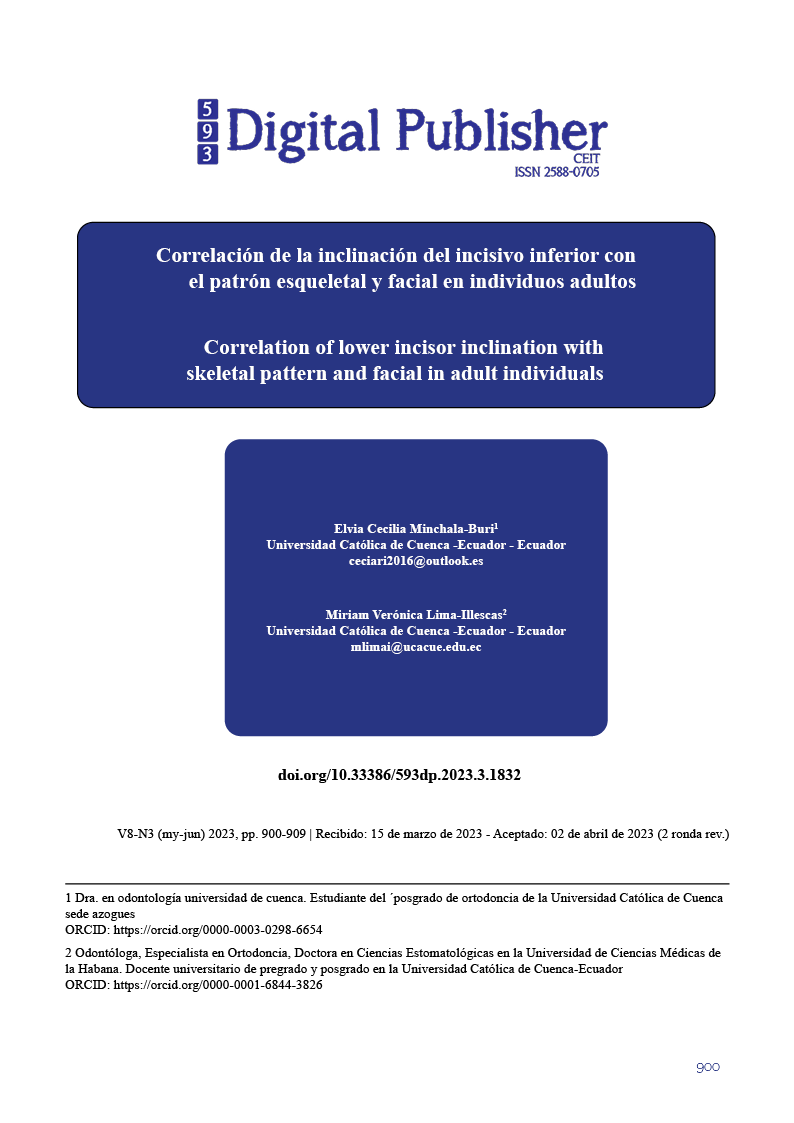Correlation of lower incisor inclination with skeletal pattern and facial in adult individuals
Main Article Content
Abstract
The position of the lower incisors is considered extremely important when planning an orthodontic treatment because it influences facial aesthetics and the optimal development of orthodontic treatment. It can also be related to factors such as skeletal pattern, facial, periodontal health, and perioral musculature. The objective was to evaluate the correlation of the inclination of the lower incisor with the facial and skeletal pattern in adults. Two hundred seventy-six digital lateral cephalic radiographs of the skull of individuals from 18 to 50 years of age who attended a radiographic center in the city of Quito, Ecuador, during the first period of 2019 were measured. The research carried out was observational, correlational, documentary, and cross-sectional. The variables to be evaluated were: facial pattern, skeletal pattern, and inclination of the lower incisor. In the inclination of the lower incisor concerning the facial pattern in brachifacials, an average of 97,01 was obtained. While for the mesofacials the average was 94.23˚, while the dolichofacials presented an average of 91,41˚.
Regarding the inclination of the lower incisor and the skeletal pattern, an average of 96.61˚ was found in Class II, followed by Class I, with an average of 92,17˚, and finally, Class III, with 87.04. There was a significant difference between the inclination of the lower incisor about the facial (inverse and negative). That is, the greater the facial pattern, the lesser the inclination of the lower incisor.
Downloads
Article Details

This work is licensed under a Creative Commons Attribution-NonCommercial-ShareAlike 4.0 International License.
1. Derechos de autor
Las obras que se publican en 593 Digital Publisher CEIT están sujetas a los siguientes términos:
1.1. 593 Digital Publisher CEIT, conserva los derechos patrimoniales (copyright) de las obras publicadas, favorece y permite la reutilización de las mismas bajo la licencia Licencia Creative Commons 4.0 de Reconocimiento-NoComercial-CompartirIgual 4.0, por lo cual se pueden copiar, usar, difundir, transmitir y exponer públicamente, siempre que:
1.1.a. Se cite la autoría y fuente original de su publicación (revista, editorial, URL).
1.1.b. No se usen para fines comerciales u onerosos.
1.1.c. Se mencione la existencia y especificaciones de esta licencia de uso.
References
Barrera, M., Karen, L., Mendoza, L., Miguel, J., Ventura, R., & Antonio, M. (2018). Asociación entre Arcos Dentarios con el Perfil , Biotipo Facial y la revista tamé. 7(19), 716-722. https://www.medigraphic.com/cgi-bin/new/resumen.cgi?IDARTICULO=92929
Cerda-Peralta, B., Schulz-Rosales, R., López-Garrido, J., & Romo-Ormazabal, F. (2019). Parámetros Cefalométricos para Determinar Biotipo Facial en Adultos Chilenos. Revista clínica de periodoncia, implantología y rehabilitación oral, 12(1), 8-11. https://doi.org/10.4067/s0719-01072019000100008
Çoban, G., Öztürk, T., Hashimli, N., & Yağci, A. (2022). Comparison Between Cephalometric Measurements using Digital Manual and Web-Based Artificial Intelligence Cephalometric Gtracing Software. Dental Press Journal of Orthodontics, 27(4), 1-26. https://doi.org/10.1590/2177-6709.27.4.e222112.oar
De Puebla, C., Reyes-Ramírez, M., Leslie, D., Erika, E.-D., -Sarabia, A., & Gabriel, M.-Q. (2014). Asociación de Maloclusiones Clase I, II y III y su Tratamiento en Población Infantil en la. Articulo Original Rev Tamé, 2(6), 175-179.
Garcia-bertrand, I. A., & Gutiérrez-Rojo, J. F. (2019). Comparación de la Posición de los Incisivos en las Maloclusiones Clase I y Clase II de Angle. Oral Blog, 20(62), 1694-1697.
Hernández-Sayago, E., Espinar-Escalona, E., Barrera-Mora, J. M., Ruiz-Navarro, M. B., Llamas-Carreras, J. M., & Solano-Reina, E. (2013). Lower Incisor Position in Different Malocclusions and Facial Patterns. Medicina Oral, Patologia Oral y Cirugia Bucal, 18(2), 343-350. https://doi.org/doi:10.4317/medoral.18434
Hu, L., Chen, J., Pan, Z., Deng, J., Yu, R., & Xing, X. (2014). Clasificacion de la Maloclusion en los Planos Anteroposterior, Vertical y Transversal. medigraf Artemisa en linea., 97(5), 1386-1388. https://doi.org/10.1111/jace.12932
Hurtado, R., Vera, M., & Uribe, E. (2016). Inclinación del Incisivo Inferior respecto al Biotipo Facial en Pacientes Clase I Esqueletal Lower Incisor Inclination in Relation to Facial Biotype in Skeletal Class I Patients. Revista Mexicana de Ortodoncia, 4(3), 159-164. https://www.sciencedirect.com/science/article/pii/S2395921516301805
Inda-Velázquez K, Gutiérrez-Rojo J, G.-V. J. (2019). Relación del Biotipo Facial determinado con el VERT y el Patrón de Crecimiento Facial. Oral, 20(64), 1762-1765. https://www.medigraphic.com/cgi-bin/new/resumen.cgi?IDARTICULO=90264
M. Norma, A. Y. (2019). Enero-junio 2019 Ciencia Odontológica Relación Osea Intermaxilar , Coincidencia entre las Cefalometrías de Bimler ,. 16(1). https://www.produccioncientificaluz.org/index.php/cienciao/article/view/33637/35435
Maza, P., & Rodriguez, M. (2010). Cambios Cefalométricos en Pacientes Adultos con el uso de Elásticos Clase II. Odous cientifica, 11(1), 7-14. http://servicio.bc.uc.edu.ve/odontologia/revista/vol11-n1/art1.pdf
Osorno-Escareño, C., Sánchez-Galán, J. L., Martín Núñez-Martínez, J., Huitzil-Muñoz, E., Sáenz-Martínez, L. P., Ensaldo-Carrasco, E., & Cenoz Urbina, E. (2019). Biotipo Facial y su Relación con la Máxima Fuerza de Mordida. Facial Biotype and its Relationship with Maximum Bite Force., 20(64), 1758-1761. http://search.ebscohost.com/login.aspx?direct=true&db=a9h&AN=141186664&lang=es&site=ehost-live
Paolina Gómez-Medina, I., David, ;, Aguilar-Pérez, A., Gabriel, ;, Colomé-Ruíz, E., Iván, ;, Zúñiga-Herrera, D., Escoffié-Ramírez, M., José, ;, Herrera-Atoche, R., Jacqueline, ;, Rodríguez-Chávez, A., Fernando, &, & Aguilar-Pérez, J. (2020). Evaluation of Diagnostic Agreement Among Cephalometric Measurements for Determining Incisor Position and Inclination Evaluación de la Concordancia Diagnóstica entre Mediciones Cefalométricas para la Determinación de la Posición e Inclinación de los Incisivios Int. J. Morphol, 38(5), 1386-1391.
Parise Juan, Villareal Byron, Viteri Andres, & Armas Ana. (2020). Frecuencia del Biotipo Facial en Estudiantes de la Carrera de Odontología de la Universidad UTE. Frequency of Facial BGiotype in. Revista OACTIVA UC Cuenca, 5(1), 11-16. https://webcache.googleusercontent.com/search?q=cache:_BHDj3N3woQJ:https://oactiva.ucacue.edu.ec/index.php/oactiva/article/download/414/577/+&cd=24&hl=es-419&ct=clnk&gl=ec
Schulz-Rosales, R., Núñez-Guerrero, M., Cerda-Peralta, B., Rivera-Rothgaenger, M., León, E. P. de, López-Garrido, J., Danilla-Enei, S., & Romo-Ormazábal, F. (2018). Características Esqueletales para la Determinación Calitativa del Biotipo Facial en Telerradiografía Lateral: estudio piloto. Revista clínica de periodoncia, implantología y rehabilitación oral, 11(3), 164-166. https://doi.org/10.4067/s0719-01072018000300164
Tamayo-Lopera, A. (2011). Inclinacion de Incisivos . Calculo de la Cantidad de Desplazamiento Bucolingual y sus Efectos en la Longitud del Arco. 22, 227-245. https://doi.org/10.1061/9780784412121.018
Woitchunas, D. R., Filho, L. C., Orlando, F., & Woitchunas, F. E. (2012). Evaluation of the Position of Lower Incisors in the Mandibular Symphysis of Individuals with Class II Malocclusion and Pattern II Profiles. Dental Press Journal of Orthodontics, 17(3), 125-131. https://doi.org/10.1590/S2176-94512012000300023
Yassir, Y. A., Salman, A. R., & Nabbat, S. A. (2022). The Accuracy and Reliability of WebCeph for Cephalometric Analysis. Journal of Taibah University Medical Sciences, 17(1), 57-66. https://doi.org/10.1016/j.jtumed.2021.08.010
Zamora, C. (2004). Compendio de Cefalometria (pp. 47-63).



